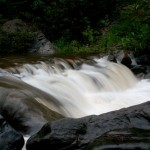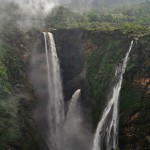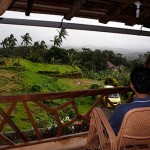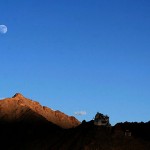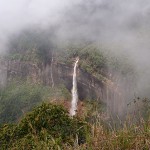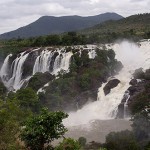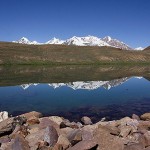I spent the September busy, if not pretending to be busy. To tell you the truth, all I did was to travel and muse about travel. A trip to Shimla kept me in in a mood for mountains for a long time, when all I did was to let my thoughts linger there. As they often say these days, I needed another holiday to get over the holiday mood.
This time the destination was the hills of Mullayyanagiri bordering the Bhadra Wildlife Sanctuary. It was going to be an inactive holiday – no intensive travel, no exploring, no photography. No activity, that’s all!
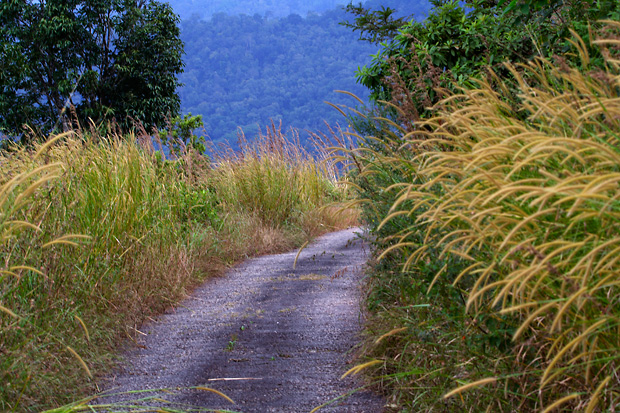
A file photo of a road near Mullayyanagiri
We had left Bangalore on a rainy afternoon and arrived at Chikmagalur at 11pm – a little later than we would have liked to. It was still drizzling as we got into the rugged jeep that took us deeper into the hills. We drove on a wet and misty road towards the hills of Mullayyanagiri with no thoughts in the mind but to quickly reach the destination and retire for the day. I would have liked it if we were on this road during the day, when one could see the lush grass on the slopes, and when weather permits, rolling hills or the plains of Chikmagalur. But not to feel bad, we were to spend two days in a coffee estate nestled in the depth of these hills.
With us in the jeep was Prasad, the cheerful driver and the estate manager Cariappa. Cariappa kept to himself first but quickly got talking when Prasad started a conversation.
‘I have been managing the plantations here for 33 years now. There are multiple estates spread in different locations around Chikmagalur…
‘I am from Ammathi at Coorg. I would like to go back to Coorg now but they would not let me..’
‘We always used to spot some or the other wild animals on the way to the estate. There was nothing today, not even a deer or boar..’
We reached the estate exactly at midnight. Having arrived in the dark, I had no clue about the location and setting of the estate. It wasn’t much different next morning either, when I woke up to see a thick fog blocking my views. But with whatever little I could see through the fog once in a while, it did seem like a beautiful place. Occasional holes in the blanket of moving fog revealed me a hill covered with thick tropical vegetation at its base and a silver-oak plantation near its grassy ridge. It seemed like there was a valley far below hidden in the fog that I would never get to see in the days I was to spend there.
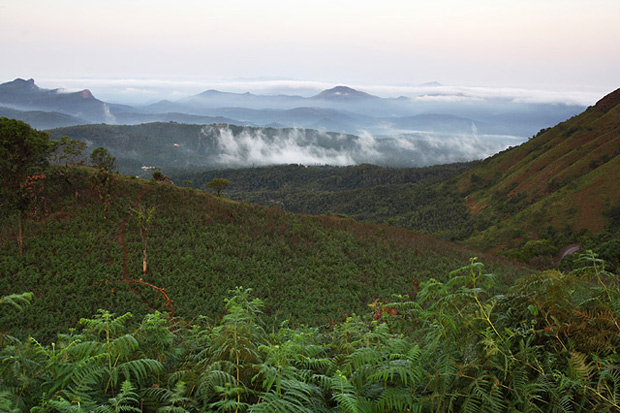
A file photo of hills near Mullayyanagiri
Within my views were the coffee plants spread on the slopes, a few buildings within the coffee estate and the dirt roads that crisscrossed the area. A silhouette of tall Silver Oaks stood parallel to each other in the fog. The trees in the estate looked wet, fresh and green, washed by three months of monsoons. The place looked mysteriously beautiful in the foggy weather, but left me in anticipation of seeing the landscape behind the depth of the fog.
Sitting back on my chair in the balcony with a book in my hand that morning, I watched the wind carry the clouds away and bringing in a fresh lot every now and then. The day was just unfolding for me, and also for the birds in the forest. I excitedly watched a barbet land on a tree very close to where I sat. A grey wagtail came closer and landed on the roof before it saw me and flew away. Malabar Parakeets made long distance flights between gaps in the canopy, squeaking loudly in flight. Red Whiskered Bulbuls inspected the nearby bushes, probably in search of worms. I watched them all, drowning cup after cup of hot filter coffee that compensated for the cold mountain breeze, occasionally glancing at my book when the outside world fell silent.
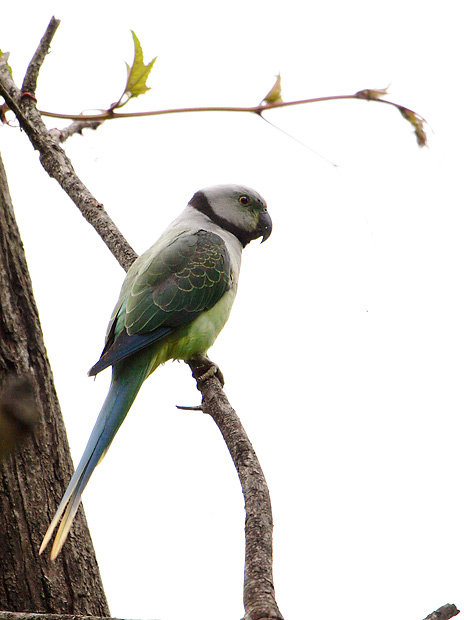
File photo of a Malabar Parakeet in Bhadra Wilderness
On a long walk past the estate later in the day, the magic of the monsoon unfolded in the slopes of the coffee country. I saw along my way, a bell-shaped purple flower with tiny water droplets on its petals that kept it fresh and beautiful. As I bent down to take a closer look, a tiny insect walked out from the heart of the flower, having had a stomach full of nectar. I peeped in closer to see two more of its kins busy feeding. A little later, I found a bee-like insect hovering over small yellow flowers, sucking the juice with ease with its long and sharp suction pipe located on its nose, which allowed it to easily delve deeper into the flower. Big butterflies of all colours hovered on the blooming flowers – one with a greenish wing with a strip of bright white, another with dark wings with a sparkling blue patch and another one bight yellow.
Up on the trees with their barks crowded with lichens, birds fluttered and sang happily. I saw a scarlet minivet that stood out in the greenery with its crimson plumage, a bunch of babblers, a flock of white-eyes and a large number of bulbuls. A hawk cuckoo sat graciously on a branch and inspected its surroundings. On a sharp curve along a steep slope where the trees were spread thinly to keep the coffee in shade, the mid-day symphony of the cicadas amplified into an almost ear-piercing clamour. Streams emerged from the slopes, appearing pristine but probably laden with pesticides from the coffee plantations sprayed before the monsoons. Fog disappeared slowly with progress of the day, revealing smooth grass laden slopes above the treeline.
A let up in the fog reveled the valley of Bhadra later in the day. In the view was thick uninterrupted greenery covered the wide basin of the valley, with hills rising again at the far end. Reflection from the waters of Bhadra Reservoir sparkled brightly near the horizon. Fog played with the scenery like a curtain raising and falling, sometimes letting in just a glimpse of the wide expanse of the vista.
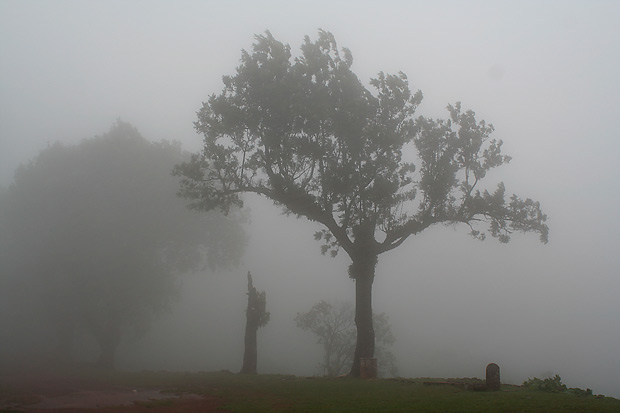
File photo – A foggy day near Mullayyanagiri
Later in the day, I spoke to Aravaind, the estate owner and former forest ranger, about the conservation efforts in Bhadra Wildlife Sanctuary. The reserve makes a good examples of rehabilitating people who once lived in the park and depended partially on the forest for livelihood. When the sanctuary was notified, the villagers in the forest were efficiently rehabilitated and every family was given arable land elsewhere in the district.
‘Some villages were deep in the forest. They had to walk for two hours to get to the nearest shop,’ Aravind told me, ‘so if they want to have some chicken for dinner, it would have been easy to go search for some fowl in the jungle than walk for four long hours.’
I have seen some results of the rehabilitation myself. In places where they had paddy fields before people moved out, you now see a bunch of bisons carelessly feasting on wild grass. Spread across an area of nearly 2,000 km², Bhadra is a tiger reserve with thick tropical forest and a population of more than 30 tigers (according 1997 census. See project tiger website). The trees here are tall and the canopy so thick, once traversing in this forest, I heard bird calls all along the way from the treetop, but never once managing to spot the origin of these sounds.
Spending another day in the foggy but pleasing weather, we drove back to Chikmagalur next day, again in darkness, again wishing that we had driven during the day.
It is one of those times when I am finding it hard to write, and postponing new posts day after day. There is much to write, nevertheless. A lot of Ladakh is waiting to be written. Many of the experiences from Ladakh have been inscribed into my travel journal, but there is a lot more that needs recollection from memory. And then there are stories to write from some short journeys, like spending time along the beaches of Goa.
At the moment, I am sitting in a small town in Malnad region, enjoying the experiences of the rain. I might as well write a bit about what is happening in front of me.
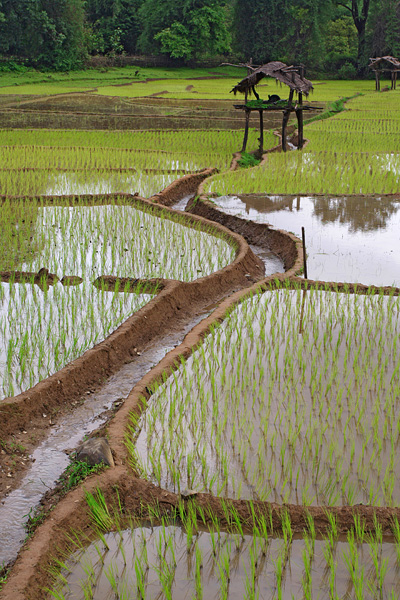
File photo of paddy fields in the monsoons
It is cloudy here through the day, and rarely does the sun come out to say a quick hello before he disappears. There is a gentle breeze blowing most of the time keeping the air fresh and the weather pleasant. The temperature is just perfect, slightly on the colder side but not cold enough to take out warm clothes from the closet. I am sitting on an easy-chair on the veranda, sometimes reading something, munching something nice and hot, answering phones or trying to write this post. Distractions are many, when you are not too keen to write. And I am not in a hurry either.
After some letup for the first two days I was here, it poured well this afternoon. Rain excites me and makes me feel good, and I can just go on staring at the world. As I watched from the porch, a Magpie Robin flew in and rested on the grill, its whole body wet. Water drops dripped from its wings. It did not look like a happy bird as it shivered a bit, shook its body vigourously and tried to get the water out. They say someone’s misery can be another’s happiness: it was my turn to feel happy as I silently sat in my chair snugly, watching the Magpie.
Birds have been entertaining me well here, even when rains were absent for last two days. I was walking past a paddy field yesterday, through young and lush plants half immersed in water and telling myself that I had not done this paddy field walk in a long time. Getting close to a tree, I stopped, seeing a spotted owlet with its back towards me. It preened for nearly 10 minutes as I watched, and when eventually satisfied with its just-out-of-the-beauty-parlour look, decided to look around and see if the world is ready to receive it. And then having seen me watching him/her, its instincts kicked in suddenly, it’s neck elongated with added alertness. It flew away the next moment.
Along the paddy field was a meadow where many birds went on living their every day life. Some lapwings walked back and forth looking for food and calling their counterparts with a shrill voice when they found something. Bea Eaters sat on power lines and inspected the insects in their periphery. Scaly Breasted Munias hung around in small groups, again on the power lines. The lines seem to be favourite of every one: they hosted magpies, red whiskered bulbuls, mynahs and occasionally even treepies. Larks and lapwings were an exception – they preferred the meadow. And parakeets sat only on the guava tree in the garden, searching for ripe fruits. When they did not find anything of intrest, they let out a quick squeak and flew away, without wasting any time to sniff around and search thoroughly. Sparrows did not seem to have a taste about perches. They shifted location between power lines, meadows and anything else they could think of. Sometime they chirped continuously, sitting on window grills not very far from the porch where I sit and watch the rain from. When it rained, some of them disappeared and went into hiding somewhere. But thick skinned crows did not seem to care much and continued doing their work.
Buffaloes seemed equally thick skinned. After a passing rain, they sat on the small puddles formed in the meadow, trying to be as inert as possible. They barely moved an inch, staying perfectly still until a crow or a pond heron flew in to disturb one of them. A quick shake of head and the birds would fly away, allowing the buffaloes to return to their meditation. It must be a good life, being a buffalo.
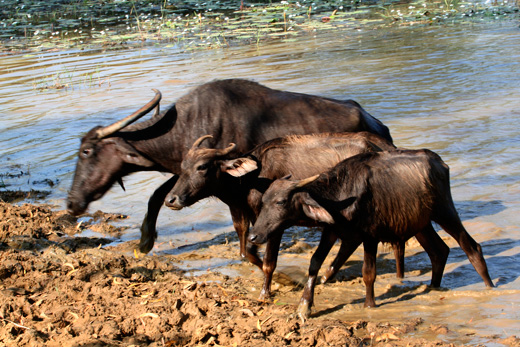
File photo of buffaloes emerging from water
I am probably not being a great deal different from the buffaloes. My hands are typing something, and sometimes I talk, listen or munch, but rest of my body is doing little else. It is last day of idling for me, until I return to the city and continue the not-so-busy life I lead. But the buffaloes have time to while away till the monsoon recedes.
